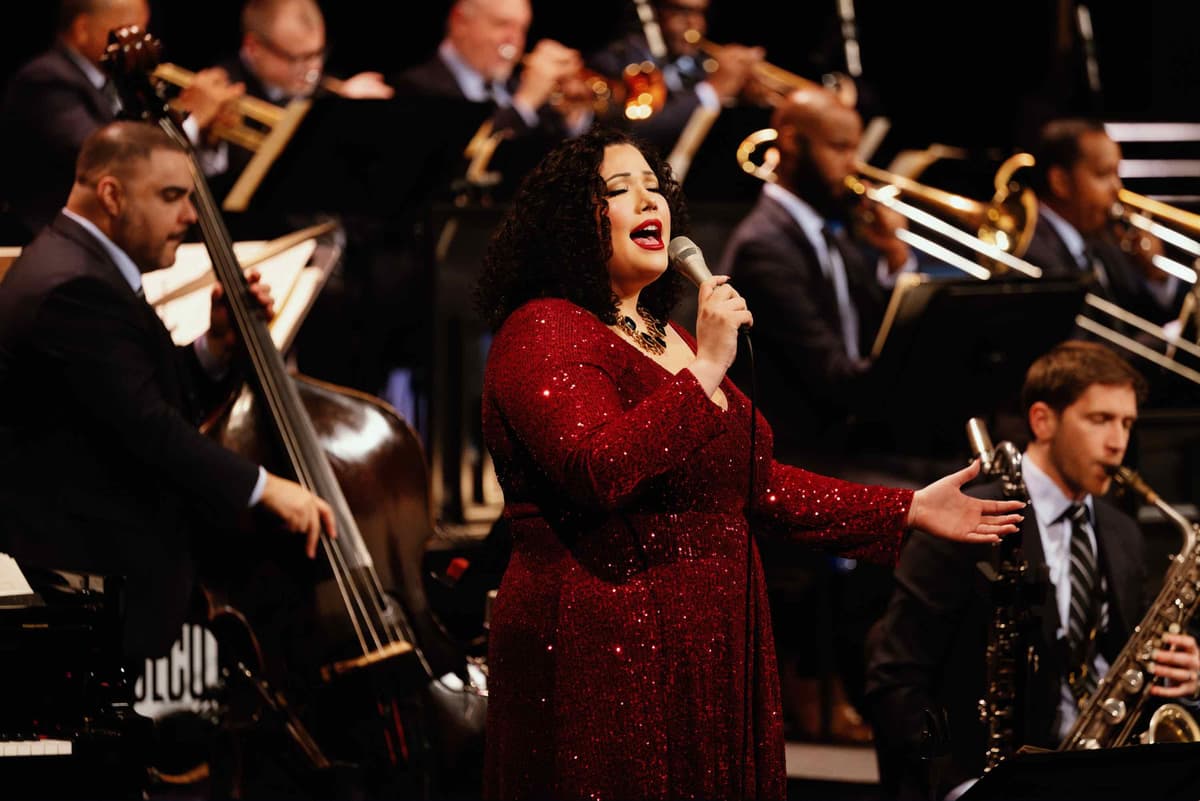Holiday Standards, Old and New, Are Refracted at Lincoln Center Through the Prism of Jazz
The programs offer an agreeable mix of the old and the new, the swinging and even the sacred, as rendered by the orchestra’s usual cast of top flight arrangers and soloists, as well as a roster of exceptional vocalists.

Jazz at Lincoln Center Orchestra with Wynton Marsalis
‘Big Band Holidays’
Jazz at Lincoln Center, Rose Hall, Broadway at West 60th Street
Through Sunday, December 17
‘Big Band Holidays III’
Blue Engine Records
“Jingle Bells” might be the earliest secular Christmas song — as opposed to a traditional hymn or a spiritual — that’s still regularly performed. Historian and archivist Harry Arends recently discovered a cylinder recording of “Jingle Bells” from about 1900 that might be the earliest (of many thousands) of recorded versions of the song, and certainly one of the first-ever Christmas records.
It’s also a jazz standard, being one of the few tunes that I can think of that was rearranged and reinterpreted by Benny Goodman, Fats Waller, Count Basie, Duke Ellington, and hundreds of other great musicians.
The Jazz at Lincoln Center Orchestra begins its annual “Big Band Holidays” with Sherman Irby’s arrangement of “Jingle Bells,” which they recorded on their 2015 album of that title; the third volume in that series, “Big Band Holidays III” is being released today.
Mr. Irby’s “Jingle Bells” features two soloists, and, coincidentally they are the newest and youngest member of the orchestra, saxophonist Chris Lewis, and the man who, if not the oldest, is certainly the first man in the band, founder, artistic director, and trumpeter Wynton Marslis.
The combination of the old and the new speaks to the tradition of holiday music, especially as it’s refracted through the prism of Jazz at Lincoln Center and Mr. Marsalis, who first recorded a version of “Jingle Bells” on his original “Crescent City Christmas Card” album 35 years ago.
In all of its holiday outings, the Jazz at Lincoln Center programs offer an agreeable mix of the old and the new, the swinging and even the sacred, as rendered by the orchestra’s usual cast of top flight arrangers and soloists, as well as a roster of exceptional vocalists.
Ashley Pezzotti sang exquisitely on the swinger, “Let It Snow! Let It Snow! Let It Snow!,” the ballad “Have Yourself a Merry Little Christmas,” the religious “O Holy Night,” and her own original, “Snowbird,” a kind of anti-winter hymn about deserting the snowy north in favor of sun and sand.
Ms. Pezzotti doesn’t appear on the new “Big Band Holidays III,” but I’m grateful for the presence of Denzal Sinclaire, a Canadian singer who honors Nat “King” Cole’s deep connection to the holiday with two surprisingly swinging tracks, “Caroling, Caroling” and “All I Want for Christmas Is my Two Front Teeth.”
Another Cole-inspired crooner, the South African-born Vuyo Sotashe, sings on “What Child is This,” an interpretation in the same vein as John Coltrane’s “Greensleeves.” These new arrivals fit in perfectly with Gregory Porter singing another offbeat Cole Christmas favorite, “Cradle in Bethlehem,” on the original 2015 Holidays album.
The second half of Thursday night’s concert opened with a new chart by trumpeter Kenny Rampton that immediately goes on my Christmas shortlist: “Heat Miser,” from the 1974 special “The Year Without a Santa Claus.” The utter whimsey and high spirits of this number encapsulate everything that’s great about Jazz at Lincoln Center’s ongoing holiday “franchise.”
Introduced by a baroque trumpet fanfare, “Heat Miser” is played as a jaunty, show-tune-y two-four, with the melody stated by Mr. Rampton growling into a cup mute. The chart gets progressively hipper as it continues, even while remaining in a two-beat — if Jimmie Lunceford had lived long enough to make a Christmas album, this is what it would sound like.
The second act moved from the cartoony to the congregational, and concluded with a chart by trombonist Chris Crenshaw of “Go Tell It On the Mountain,” in which the traditional spiritual tune is stated by Mr. Crenshaw and the other two long standing members of the trombone section, Vincent Gardner and Elliot Mason.
We might think that religious numbers are the most reverential, but this and “No Room at the Inn,” sung by Catherine Russell, which winds up the album, are the loudest, most spirited, rabble-rousing and crowd pleasing numbers in either program.
The only disappointment with the concert was that it was over too quickly – each half was only 40 minutes, and there were a lot of Jazz at Lincoln Center arrangements I still wanted to hear, like Claude Thornhill’s “Snowfall.” Perhaps the programmers wanted to extend the socializing aspect of the concert; this was one show where everybody in the house seemed to know each other.
The concluding “Go Tell It on the Mountain” had the entire hall on their feet and cheering. The orchestra brilliantly wrapped up every fun aspect of the holiday, the familial and the social, Santa Claus and the New Testament, parties and prayers, into one pretty package tied up with a big red bow.

